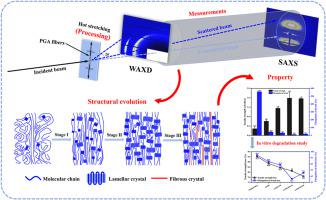Polymer ( IF 4.1 ) Pub Date : 2023-10-12 , DOI: 10.1016/j.polymer.2023.126417 Jin Guo , Huashuai Cui , Yushuang Miao , Yeshun Zhong , Jintang Zhu , Yiguo Li , Zongbao Wang , Juming Yao

|
The properties of polyglycolide (PGA) fibers used as surgical sutures depend on their aggregated state structure. The study investigated the relationship between the structural evolution and macroscopic properties of PGA fibers with low-crystallinity under coupled stress-temperature fields by conducting in-situ WAXD/SAXS, DSC and SEM measurements. The WAXD and SAXS results indicated that the structural evolution during the low-temperature stretching stage primarily relied on stress-induced amorphous molecular chain orientation and the formation of small crystals. The DSC results confirmed that uniaxial stretching enhanced the orientation of amorphous molecular chains, leading to cold crystallization of PGA fibers at lower temperatures. During the heating stretching stage at temperatures of 60–90 °C, numerous crystals were generated through a lamellar insertion mechanism and underwent lateral growth. This is reflected by the crystallinity, crystal orientation, and crystallite sizes increased significantly, while the long period decreased rapidly. The high-temperature stretching stage resulted in fragmentation and recrystallization of lamellar crystals, forming fibrous crystals. Stretching at 110 °C exhibited higher Iq2/Iq1 values than other temperatures, which means that 110 °C is more favorable for the formation of fibrous crystals. Additionally, PGA fibers stretched at 150 °C exhibited the highest crystallinity and crystal orientation, which led to a 440 % increase in tensile strength. Its resistance to degradation has also been significantly improved compared to the original fibers.
中文翻译:

应力-温度耦合场下可生物降解聚乙交酯纤维的结构演化及其对性能的影响
用作手术缝合线的聚乙交酯 (PGA) 纤维的特性取决于其聚集态结构。该研究通过原位WAXD/SAXS、DSC和SEM测量,研究了低结晶度PGA纤维在应力-温度耦合场下的结构演化与宏观性能之间的关系。WAXD和SAXS结果表明,低温拉伸阶段的结构演化主要依赖于应力诱导的非晶分子链取向和小晶体的形成。DSC 结果证实,单轴拉伸增强了非晶分子链的取向,导致 PGA 纤维在较低温度下冷结晶。在60-90℃的加热拉伸阶段,通过层状插入机制产生大量晶体并进行横向生长。这体现在结晶度、晶体取向和微晶尺寸显着增加,而长周期迅速下降。高温拉伸阶段导致层状晶体碎裂和再结晶,形成纤维状晶体。110℃拉伸比其他温度表现出更高的Iq 2 /Iq 1值,这意味着110℃更有利于纤维状晶体的形成。此外,在 150 °C 下拉伸的 PGA 纤维表现出最高的结晶度和晶体取向,从而使拉伸强度提高了 440%。其抗降解性能较原纤维也有显着提高。































 京公网安备 11010802027423号
京公网安备 11010802027423号